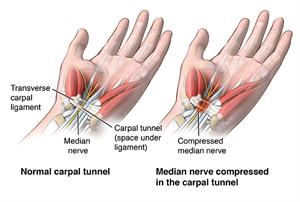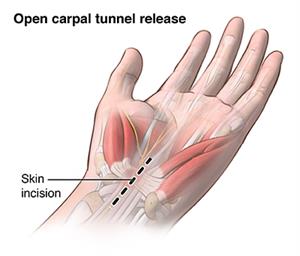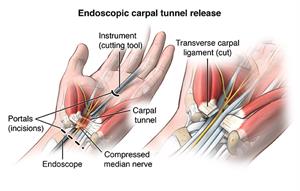Carpal Tunnel Release
What is carpal tunnel release surgery?
Carpal tunnel release is surgery to treat carpal tunnel syndrome. Doctors used to think that carpal tunnel syndrome was caused only by an overuse injury or a repetitive motion done by the wrist or hand, often at work. It's now thought that those can be partly responsible.
There are other factors also involved. They are all related to increased pressure on the median nerve as it passes through the wrist. Some people have a small carpal tunnel because the condition runs in their family (congenital predisposition). Carpal tunnel syndrome can also be caused by injury. This includes a sprain, a fracture, or the repetitive use of a vibrating tool. It's also been linked to pregnancy, diabetes, thyroid disease, and rheumatoid arthritis.
The median nerve and tendons that allow your fingers to move pass through a narrow passageway in the wrist called the carpal tunnel. The carpal tunnel is formed by the wrist bones on the bottom and the transverse carpal ligament across the top (or inside) of the wrist. Swelling of the tissues within the tunnel can press on the median nerve when this part of the body is injured or tight. If not treated, it causes numbness and tingling of the hand, pain, and loss of function. Symptoms usually start slowly. They may get worse over time. They tend to be worse on the thumb side of the hand. A person may have carpal tunnel syndrome in both hands.

During carpal tunnel release surgery, a surgeon cuts through the ligament that is pressing down on the carpal tunnel. This makes more room for the median nerve and tendons passing through the tunnel. It usually improves pain and function.
Why might you need carpal tunnel release surgery?
You may need this surgery if you are diagnosed with carpal tunnel syndrome. And even then, your doctor will likely want you to try nonsurgical treatments first. These may include:
-
Over-the-counter pain medicines.
-
Physical therapy.
-
Changes to the equipment you use at work.
-
Wrist splints.
-
Shots of steroids in the wrist to help ease swelling and pain.
The reasons that your doctor would recommend surgery may include:
-
The other treatments for carpal tunnel syndrome don’t relieve the pain.
-
Your doctor does an electromyography and nerve conduction test of the median nerve. They then determine that you have carpal tunnel syndrome.
-
The muscles of your hands or wrists are weak and getting smaller. This is because of the severe pinching of the median nerve.
-
The symptoms of carpal tunnel syndrome have lasted a long time with no relief.
What are the risks of carpal tunnel release surgery?
As with most surgeries, carpal tunnel release has some risks. Your wrist will be made numb and you may be given medicine to make you sleepy and not feel pain (called local anesthesia) for the procedure. In some cases, general anesthesia is used. This is when medicines are used to put you into a deep sleep during surgery. Anesthesia poses risks for some people. Other possible risks of this surgery include:
-
Bleeding.
-
Infection.
-
Injury to the median nerve or nerves that branch out from it.
-
Injuries to nearby blood vessels.
-
A sensitive scar.
-
The need for more surgery.
Recovery from this surgery takes time. It can be anywhere from several weeks to several months. Recovery may take even longer if the nerve has been compressed for a long time. You'll have a splint on your wrist. You will also get physical therapy to strengthen and heal your wrist and hand.
There may be other risks. It depends on your specific medical condition. Talk about any concerns with your doctor before the procedure.
How do you get ready for carpal tunnel release surgery?
-
Tell your doctor about all medicines you take. These include over-the-counter medicines, vitamins, herbs, and supplements. You'll probably need to stop taking any medicines that make it harder for the blood to clot, such as ibuprofen, aspirin, or naproxen.
-
If you smoke, try to quit before the surgery. Smoking can delay healing.
-
You may need to get blood tests or an electrocardiogram before surgery.
-
Follow any directions you are given for not eating or drinking before surgery.
Your doctor may have you do other things to get ready based on your medical condition.
What happens during carpal tunnel release surgery?
This is usually an outpatient procedure. That means that you can go home the same day as the surgery if all goes well. There are three types of carpal tunnel release surgery. The traditional method is the open release. This is where the surgeon cuts open the wrist to do the surgery.

The other methods are endoscopic carpal tunnel release and ultrasound-guided carpal tunnel release. During endoscopic surgery, a thin, flexible tube with a camera is put into the wrist through a tiny cut (incision). The camera guides the surgeon. The surgeon puts thin tools into the wrist through another small cut. With ultrasound-guided surgery, the surgeon uses an ultrasound machine to put a small probe in the carpal tunnel next to the median nerve.

Here are the general steps in a carpal tunnel release surgery:
-
You will usually be asked to remove your clothing, or at least your shirt, and put on a hospital gown.
-
You will be asked to sign a surgical consent form to give your surgeon permission to do the procedure. Read the consent carefully and ask any questions you may have.
-
Typically, local anesthetic is used for this procedure to numb the hand and wrist.
-
In an open release surgery, the surgeon makes less than a 2-inch cut on the wrist. They use common surgical tools to cut the carpal ligament and make the carpal tunnel larger.
-
In an endoscopic or ultrasound-guided surgery, the surgeon makes a 1/2-inch cut on the wrist. Then they put a camera attached to a narrow tube into the cut. The camera guides the surgeon as they insert the instruments and cut the carpal ligament through the other incision. Or they use a small probe without a camera. When there is no camera, the ultrasound device guides the surgeon on the right placement of the probe before cutting the carpal ligament.
-
The surgeon stitches up the cut or cuts.
-
Your hand and wrist will be placed in a splint or bandaged heavily to keep you from moving your wrist.
Once the surgery is done, you’ll be watched for a short time. Then you can go home. In rare cases, or if there are problems, you will need to stay overnight.
What happens after carpal tunnel release surgery?
Your wrist will likely be in a heavy bandage or a splint for 1 to 2 weeks. Doctors usually schedule another appointment to remove the bandage or splint. During this time, you may be encouraged to move your fingers to help prevent stiffness.
You’ll probably have pain in your hand and wrist after surgery. It’s usually controlled with pain medicines taken by mouth. You may need to elevate the affected hand above your heart while sleeping at night. This will help to decrease swelling.
You'll likely begin a physical therapy program once the splint is removed. The physical therapist will teach you motion exercises to improve the movement of your wrist and hand. These exercises will speed healing and strengthen the area. You may still need to sometimes use a splint or brace for a month or so after surgery.
The recovery period can take anywhere from a few days to a few months. You may need to adjust job duties or take time off from work while you heal. Your doctor will talk to you about activity restrictions you should follow after surgery.
Let your doctor know if you have:
-
A fever.
-
Redness, swelling, bleeding, or other drainage from the incision.
-
Increased pain around the incision.
These problems may need to be treated. Talk to your doctor about what you should expect. And ask what problems to watch for. With some problems, you'll need to see your doctor right away.
Next steps
Before you agree to the test or procedure make sure you know:
-
The name of the test or procedure.
-
The reason you are having the test or procedure.
-
What results to expect and what they mean.
-
The risks and benefits of the test or procedure.
-
What are the possible side effects or problems from the test or procedure.
-
When and where you are to have the test or procedure.
-
Who will do the test or procedure and what that person’s qualifications are.
-
What would happen if you did not have the test or procedure.
-
Any alternative tests or procedures to think about.
-
When and how you will get the results.
-
Who to call after the test or procedure if you have questions or problems.
-
How much you will have to pay for the test or procedure.